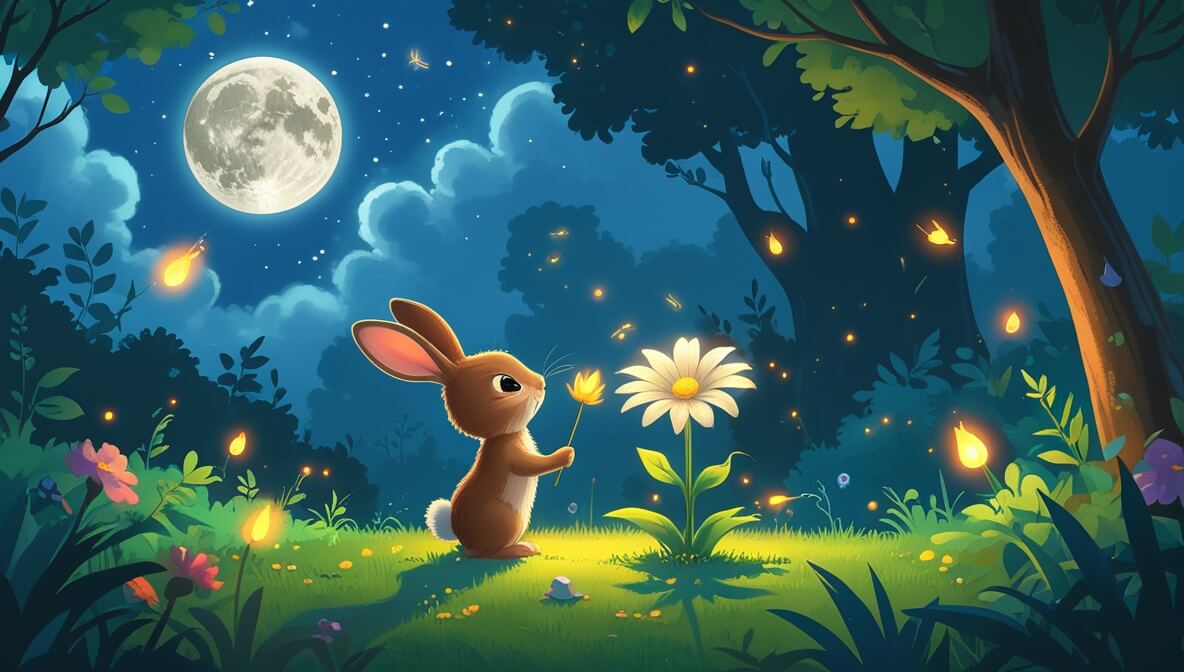Once upon a time, in a cozy little garden, lived a tiny rabbit named Pippin who loved to explore. One day, he discovered a magical flower that only bloomed under the moonlight.
Age Recommendation
0 – 4 years
Characters
Characters:
- Pippin (a curious and adventurous little rabbit)
- Moonbeam (a magical flower that glows under the moonlight)
Story
Pippin, the little rabbit, loved to hop around his garden. One night, he noticed something shimmering in the corner. It was a magical flower named Moonbeam. “Hello, Pippin,” said Moonbeam. “I only bloom when the moon is high.”
The Moon’s Glow
Pippin watched in awe as Moonbeam opened her petals. The garden filled with a soft, silver light. “Wow, you’re beautiful!” said Pippin. Moonbeam giggled. “Would you like to see the garden in a different light?” she asked.
An Adventure Under the Stars
Pippin and Moonbeam decided to explore the garden together. They met friendly fireflies and danced with the shadows. “Thank you for showing me the magic of night,” said Pippin. “You’re welcome,” Moonbeam replied. “Remember, there’s always wonder around us, even in the dark.”
The end.
Moral of the Story
The story teaches us that there is beauty and magic in exploring new things, and sometimes, the darkest nights can bring the brightest surprises.
Questions to Think About
- What did Pippin discover in the garden?
- Why was Moonbeam special?
- Have you ever seen something magical at night?
- How do you feel when you explore new places?
- What other magical things can you imagine finding in a garden?
Do You Know
- Some flowers bloom only at night, like the moonflower!
- Fireflies light up because of a process called bioluminescence.
Word Explorer
- Shimmering: Sparkling with a soft, gentle light.
- Petals: The colorful parts of a flower.
- Bioluminescence: When living things make their own light.
Emotions in the Story
- Curiosity: Pippin felt curious when he saw the shimmering in the garden.
- Amazement: Pippin felt amazed by Moonbeam’s magical glow.
- Joy: Pippin felt joyful exploring the night with Moonbeam.
Color Your Scene
Imagine Pippin and Moonbeam in the garden, surrounded by glowing fireflies and shadows dancing in the moonlit night. Draw the scene with soft silver, deep blue, and tiny golden lights all around.
Parents’ Corner
This story is a wonderful conversation starter to introduce your child to:
Curiosity and Exploration: Discuss how Pippin’s curiosity led to a beautiful adventure.
Finding Beauty in Unlikely Places: Talk about how the night, often seen as dark and scary, became a magical place.
Imagination and Creativity: Encourage your child to think about other magical things they might find in their own world.
Friendship and Wonder: Highlight the bond between Pippin and Moonbeam, and how sharing experiences can create lasting friendships.











